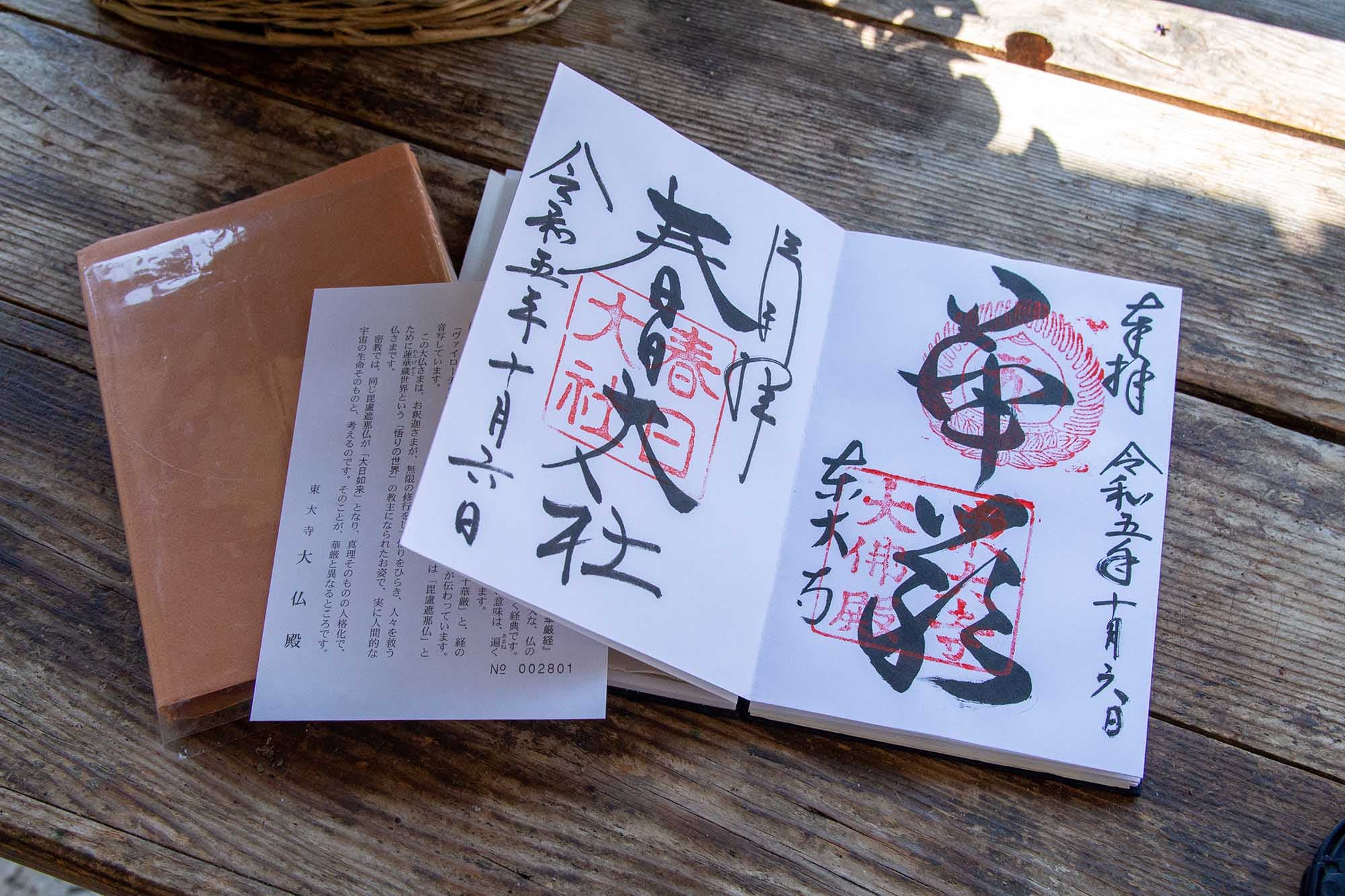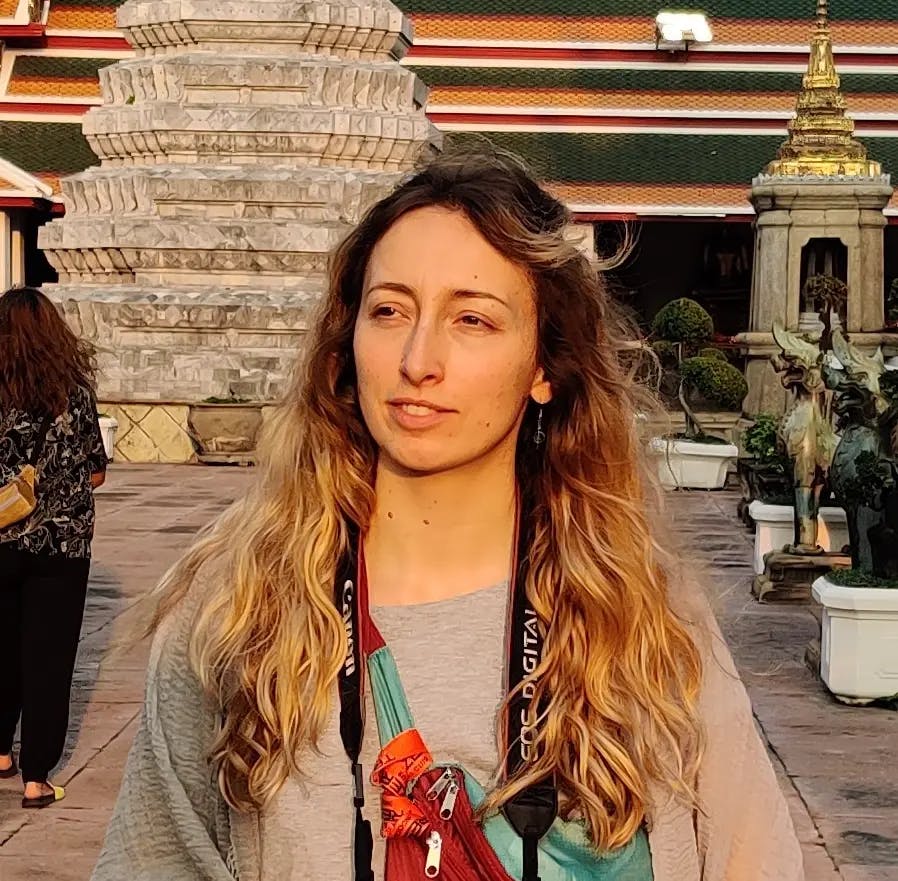The next day, we decided to wonder around and visit Kushida Shrine. We absorbed the peacefulness - which we didn’t realise would always seems to be present during visits to Japanese temples - and admired the architecture, the beautiful details of the shrine and all the different offerings placed around the temple—wooden plaques with visitor’s wishes, bottles of sake, bags of rice, and colourful origami cranes folded by visitors hoping for good fortune.
I then noticed a few people queuing at the shrine office and forming another small queue just further along. I realised that someone inside was handing out what looked like small A5 books. As a bit of a stationery fanatic, I was immediately intrigued and moved closer and noticed someone painting beautiful characters on small books before handing them to the visitors in line.
The calligrapher’s brushwork was so smooth and detailed that it was beautiful to watch. Every brushstroke was made with such care and precision. In Japan, you are supposed to receive things with both hands rather than just taking them with one. Each devotee thanked the calligrapher and extended both hands to collect their precious goshuin book, bowing respectfully as they received what I would soon learn was far more than just a beautiful piece of stationery.
I began to wonder how this tradition started and whether it inspired the stamp collection tradition in other, less spiritual places.
What is a goshuin stamp?
I will explain in detail throughout the rest of the article, but put simply: goshuin (御朱印) translates to “honourable red seal”, which gives you an idea of their importance. Each goshuin stamp is created by Buddhist temple monks or Shinto shrine priests using brushes and ink. The stamp contains the site’s name, the date of your visit, and sometimes prayers or blessings. These are painted on a page of a book dedicated solely to goshuin stamps.

Goshuin Stamp
What is a goshuincho and where can you buy it?
The goshuincho is the hardback book in which people collect their stamps. This book is accordion-style with thick paper and often comes with a decorated cover made from canvas, washi paper or wood. Many people select their book carefully at bookshops or stationery stalls, where there may be a wider selection of covers. However, goshuin books can also be bought at goshuin stands in temples for anything between 1,500 and 3,000 yen. When I bought mine, I chose a simple black canvas one, partly because it was the only option available at the temple’s office but also because I liked the idea of keeping it minimal.
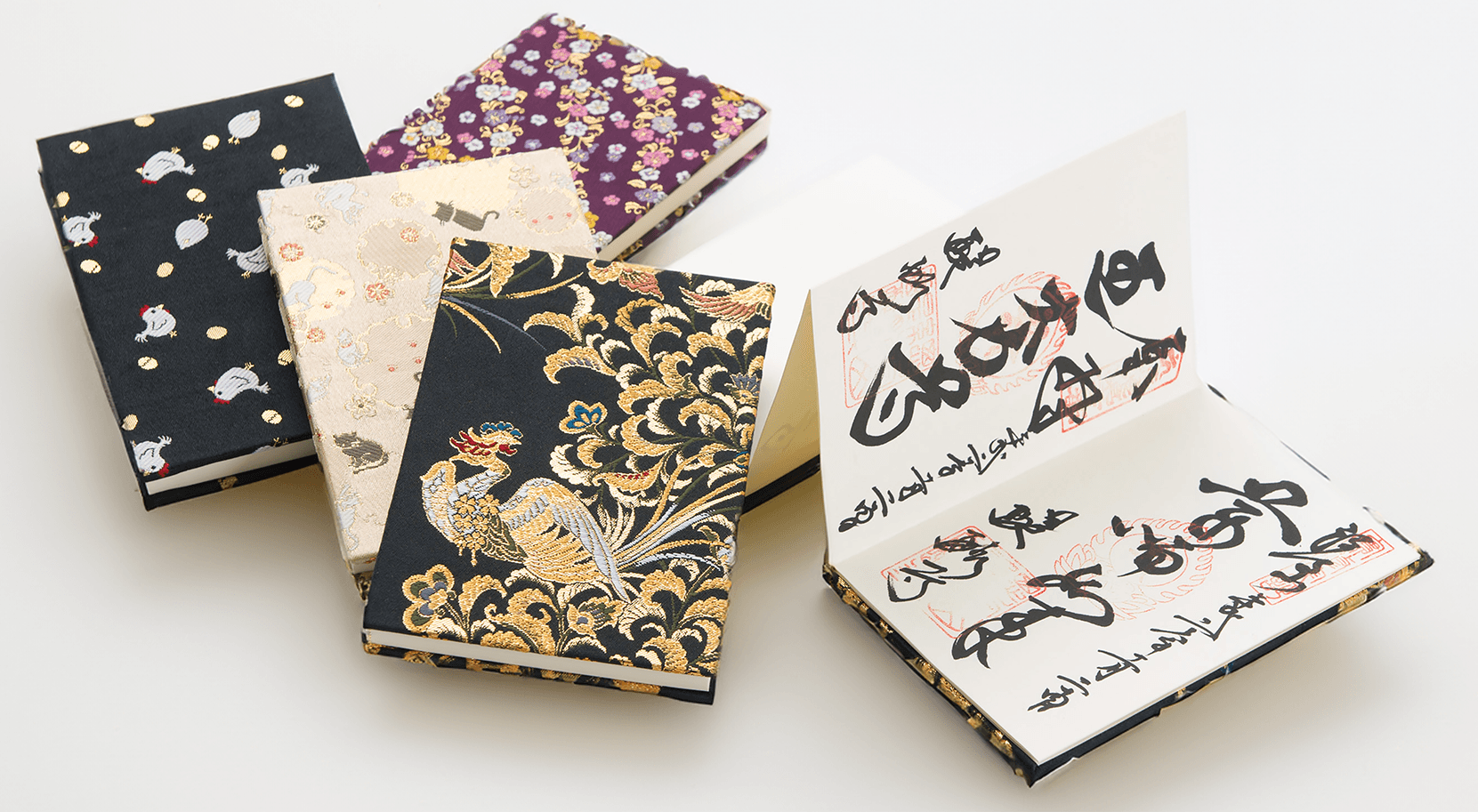
Multiple goshuinchos. Photo credit: reiseido.net/en/
The historical roots of Japan's spiritual goshuin tradition
From what I found on other websites and blogs, goshuin stamps date back to the 8th century, when they were given to noble pilgrims as proof of their dedication to the religion and as a symbol of their prayer offering to a specific religious site—almost like a passport, although this comparison slightly undermines the importance of this symbolic exchange.
Nobles and aristocrats, usually connected to the Imperial court in Kyoto, had to follow specific pilgrimage routes. Only after having made the right donations and spending enough time in worship would they be given a sacred acknowledgement.
People believed that these spiritual journeys would help them in the afterlife, atone for sins, bring healing, or fulfil religious promises. Some pilgrims even went to the extent of selling everything they owned to fund these extensive journeys.
Seasonal goshuin stamps and famous pilgrimages
Once you discover the Goshuin stamp “world” and you happen to be in Japan during a festivity or specific season, you will soon realise that many temples have special stamps for a limited amount of time and others which follow a specific pilgrimage theme.
As mentioned above, people often used to follow pilgrimage routes, which made the collection of stamps slightly more complex. Like the Cammino di San Francesco in Italy or the Santiago di Compostela routes in Spain, in Japan there are a few trails which now attract both devotees and hikers.
- Kumano Kodo: This route is about 70 km long and leads to the sacred Mount Koya, now a UNESCO World Heritage Site which is home to a settlement of around 100 Buddhist temples.
- Shikoku Henro: Also very popular, but by far the longest as it’s over 1200 km long which means that pilgrims often incorporate public transport and cars into their journey as it takes one or two months to complete by foot. There are a total of 88 temples to visit along the way as well as a chance to see very different landscapes and try a variety of local dishes. The goshuin stamp at the Daiho-ji, the 44th temple on this route, offers a very different stamp on pink
- Dewa Sanzan: The name stands for the three mountains (Mt. Haguro, Mt. Gassan, and Mt. Yudono) which represent birth, death and rebirth. These places are among the oldest for mountain worship in Japan.
- Saigoku Kannon: An old pilgrimage which dates back to over 1000 years ago and visits the 33 statues of Kannon in northern Japan, who is the Buddhist goddess of mercy.
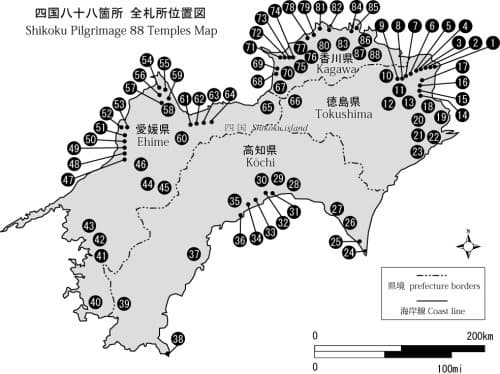
Shikoku 88 temples map. Photo credit: Kyoto Journal
How do you get a goshuin stamp?
To get a goshuin stamp, you will need to visit a Buddhist temple or a Shinto shrine. Most of them will have a goshuin stand, but some of the smaller ones might not. At larger religious sites, due to the number of visitors, you may be given a pre-made stamp on a sheet to insert into your book, or you might be asked to come back and collect it later.
There will usually be signs warning you not to take photos or videos of the process. This is to respect the spiritual moment and the privacy of the person creating the stamp.
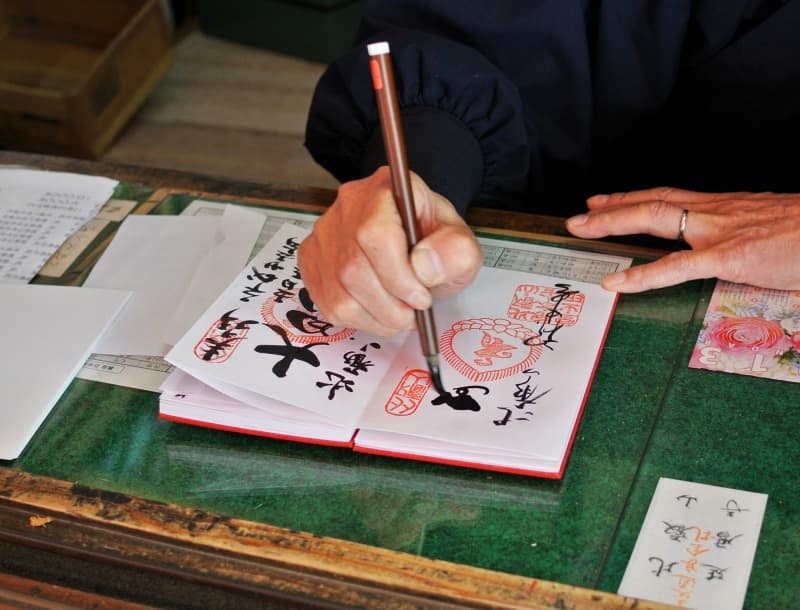
Process of goshuin stamp. Photo credit: tsunagujapan.com
Reading the stamp
Sometimes, due to artistic styles and the calligraphic changes between sites, the writing might be difficult to read even for Japanese speakers, but the large vertical characters in the centre or top of the page usually specify the location, so the name of the religious site. Parallel to this, the date of the visit will be written in smaller writing as will a possible sacred phrase such as 奉拝 (hōhai) - "respectfully worshipped; 参拝 (sanpai) - "visited and prayed”; 奉納 (hōnō) - "humbly offered". This is usually all painted in black ink.
The hanko is what authenticates the goshuin and is a red seal containing the shrine’s name, sacred symbols and the official seal of the location.
The goshuin stamps today
Nowadays, this documentation has opened up to regular visitors, meaning that people can turn up with respect and a goshuincho in hand. In fact, I was initially reluctant to buy a goshuincho and request a stamp because I was afraid of going against the religious requirements and culture, and I was obviously looking hesitant when a man came up to me and explained what I should do to receive one. I felt a bit less guilty about joining the queue at this point.
Every stamp is completely unique and is definitely still considered a sacred art. They vary in both design and colour, and sometimes they include an actual stamp. Most of them are black and red, but sometimes gold and silver are used for the more important temples, which still use quite a formal structure. Smaller temples may be more creative in their designs.
The books themselves become personal artefacts. Some people have multiple goshuincho for different themes—one for Tokyo temples, another for mountain shrines, or separate books for Buddhist temples versus Shinto shrines.
In fact, there is now a GoshuiGo app which helps with finding information on temples and shrines, such as opening hours, goshuin, entry fees, and places to eat nearby
Ritual etiquette
Although it has become more popular among people who aren’t Buddhist, and this seems generally accepted, one still needs to be careful not to be disrespectful. The main rules one should follow are:
- Do not use just any piece of paper or notepad; it must be a goshuincho.
- Wait quietly and do not film or take photographs.
- Make sure you thank the calligrapher.
- Do not give away or sell your book or stamp.
Don’t give goshuin books away as gifts
You might think this would make the perfect gift for someone, but many devotees say that it has a very deep spiritual meaning and represents a sacred connection between you and the temples you have visited. To give it to someone else would be seen as a lack of respect for the pilgrimage, and is considered quite different from giving a regular souvenir.
Why I really appreciate this practice
When I was travelling in Japan, one of the many things I appreciated was the beautifully designed details in engineering, architecture, food, and even religious rituals. Whether this is true or not, you feel the country is less plagued by the consumerist culture you might find at home, which sometimes removes the thought that goes into things. The goshuin ritual makes one appreciate the precision and care dedicated to this small book, which becomes a companion for many journeys and pilgrimages—whether taken as a devotee, traveller, or tourist. As a traveller, I found this minimalism particularly relatable.
References
https://www.japan.travel/en/blog/collecting-goshuin-shrine-and-temple-stamps/
https://www.japan.travel/en/ca/inspiration/seven-historic-pilgrimages-throughout-japan/
